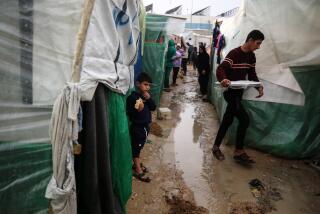The Murderous Abu Nidal : His Viciousness Should Lead Us to Try to Deal With Arafat
- Share via
It is no coincidence that Abu Nidal has selected this moment to escalate his campaign of terror by staging his bloodiest rampage yet in the Vienna and Rome airports. Austria and Italy are favorite targets for Abu Nidal precisely because these two nations are the friendliest in Europe to his archenemy, Yasser Arafat.
The airport attacks are the latest in a series. On May 1, 1981, Abu Nidal shot Heinz Nittel, Austrian transport minister and head of the Austria-Israel Friendship Society; on Aug. 30, 1981, his followers killed two people and wounded 20 in a shooting and grenade attack in the Vienna Synagogue. On Oct. 9, 1982, three weeks after the Palestine Liberation Organization chairman met with the Pope and Italy’s foreign minister and president, Abu Nidal attacked the Rome Synagogue, killing one and wounding 34.
Abu Nidal was one of the early lights in the PLO’s constellation of fighters in 1969. He became head of PLO facilities in Iraq and a member of the then-15-man inner Fatah council. But he soon became disenchanted with Arafat’s leadership and criticized him for not standing up with greater ferocity to King Hussein when Hussein ejected the PLO from Jordan in the bloody Black September of 1970.
After Arafat’s flirtation with the peace process in the wake of the Yom Kippur War, the rift widened, and Abu Nidal was drawn closer to the rejectionist front dominated by Iraq. In 1974 he carried out an unauthorized attack against the Saudi embassy in Paris as a warning to the royal family against its relative moderation. Arafat was furious, the links between the two men were severed and Abu Nidal virtually appropriated the entire Fatah facilities and personnel in Iraq; each man sentenced the other to death.
Meanwhile, Abu Nidal has spent the last decade killing not only supporters of Israel but also moderate PLO leaders in hope of stalling any progress toward a peaceful settlement. His goal remains the elimination of Israel, and he has been supported alternately by Syria, Libya and Iraq.
The list of Abu Nidal’s moderate Palestinian victims is long and tragic: Said Hammami, the first member of the PLO leadership to advocate recognition of Israel, was killed in his London office Jan. 4, 1978; Ali Yassin, PLO representative in Kuwait, June 15, 1978; Izziddin Kalaq, PLO representative in France, Aug. 3, 1978; Naim Khader, PLO representative in Brussels, June 1, 1981; Majed Abu Shrar, PLO representative in Rome, Oct. 9, 1981.
Then on April 10, 1983, at a meeting of the Socialist International in Portugal, the leading moderate in the PLO’s upper echelons--the man who had campaigned tirelessly for a peaceful settlement with Israel--Issam Sartawi, was gunned down as delegates looked on. In November, 1985, Aziz Shehadah, a lawyer and leading moderate, was killed in Ramallah, 10 miles from Jerusalem.
Those who claim that Abu Nidal struck in Austria and Italy because those two countries’ liberal policies toward the Palestinians enhance terrorists’ access should note that Abu Nidal has operated successfully wherever he chooses.
The key to Abu Nidal’s vicious intransigence may lie in his past. His brother lives on the West Bank and trades kiwi fruit and avocadoes with Israel. From him we know a considerable amount about the childhood influences on Abu Nidal. The family was one of the wealthiest in pre-state Palestine. His father, Haj Khalil, marketed 10% of all Palestinian produce to Europe. During the 1948 war the family fled its 20-room house in Jaffa for its Ashkelon villa; later it fled to Gaza, and finally to Nablus.
Though the borders to the coast were open after Nablus fell to the Israelis in 1967, his mother (his father died much earlier) never returned to Jaffa. The house had been turned into a police station. She repeatedly and bitterly told her 10 children how she had lost everything.
With the flurry of peace activity in the last few months, it is no surprise that Abu Nidal struck with such ferocity. He wants Israeli retaliation in the hope that it will derail the peace movement. He knows that even if he takes responsibility for the killings, in Western minds there is little distinction between the PLO and other Palestinians. Retaliation against the PLO will suit his aims all the more.
I listen with consternation to the Israeli officials who again knowingly indict the PLO for Abu Nidal’s carnage and claim that the two groups work together. They have never cooperated in any attack. The two terrorists in Vienna who said that they belonged to Fatah were referring to the Revolutionary Council of Fatah, Abu Nidal’s group.
Abu Nidal, who considers Arafat’s leadership illegitimate and believes himself representative of the true Fatah ideology, gave the institutions within his organization names that were identical to those of Fatah’s. His journal is called Falastin Ath Thawra, the same as Arafat’s publication, and his operative division, Al-Asifa, is the name of the military branch of Arafat’s Fatah. The Israelis know all this; my information comes from the Israel Ministry of Foreign Affairs briefing of Nov. 14, 1982.
There is considerable dispute regarding the “moderation” of the PLO and Arafat. But if the battle against terrorism is to be successful, and peace is to be given a chance in the Middle East, it is of cardinal importance that we distinguish between the Nidals and the Arafats, between those who are sworn enemies of peace and those who might yet be induced to try it.
Abu Nidal’s devilry does not by any stretch of the imagination make of Arafat an angel, but it would be a step forward if we were to keep in mind degrees of enmity. There are different responses appropriate to each, and in the end, as Moshe Dayan was fond of observing, it is with one’s enemies that peace must be made.
More to Read
Sign up for Essential California
The most important California stories and recommendations in your inbox every morning.
You may occasionally receive promotional content from the Los Angeles Times.













